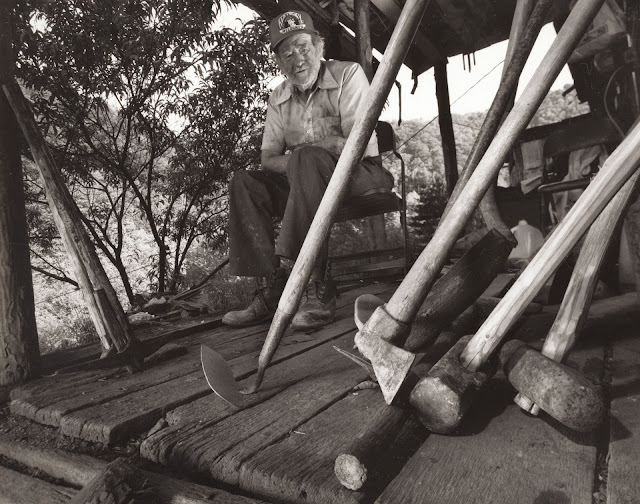Girls in Onion Patch, 2004
The repetitive making of the portraits with the physical visiting is necessary for a natural engagement. The subjects tell me their stories, leading to new associative insights and experiences only revealed to friends and trusted folks. This was never an intentional direction, more an intuitive occurrence, happening over time, again and again. Information shared contributes to more complex emotional responses recorded and the subjects selection of personal environments to be photographed in is more meaningful. Sometimes the opposite direction is taken, where a picture is made more deconstructed and simplified. That to can be revealing. From year-to-year visits can reflect life changing consequences in both photographer and subject alike, presenting the viewer with more genuine information. I sometimes ask my subjects to think about the most important events [good or bad] that has happened to them that year while I photograph them looking into the camera lens.
Lincoln, Maw and Shorty, 1992
The intent of my portraits is to inspire an unrestrained awareness and acceptance of mountain people and all people. To view and study our collaborative portraits, mirroring life in harmony and struggle together from varied perspectives is our responsibility. Probing and studying these portraits can open us to a more humble yet sustaining humanity, dissolving differences, overcoming fears, establishing meaningful connections; guiding us to find reception of each other. It is through personal reflection and focusing inwardly that one experiences empathy and compassion. Embracing our diverse humanity, discovering and seeing basic commonalities within all peoples brings about growth, helping to form unity, finding freedom from strife. Still only imagining what another's life is really like.
William and Breanna, 2008
Children at Topmost, 1991
"Unity is this: that a man feel himself to be gathered together with all his powers in the unity of his heart. Unity brings inward peace and restfulness of heart. Unity of heart is a bond which draws together body and soul, heart and senses, and all the outward and inward powers encloses them in the union of love."
—John Ruysbroeck
The Rambo Boys, 1987
Pistol City
"I find your pictures not only beautiful but truthful. You have captured the essence of the Kentucky backwoods. I saw my grandmother in those photographs. She was born and raised in Bailey Switch, a holler between Corbin and Barbourville. It's the eyes that say it all in my opinion. There is a lifetime of hard work, lack of modern convenience, and just plain hard-living that gives their eyes a haunting quality I find comforting and real. "
—Amy Silverton, Kentucky Native
 |
The Home Funeral, 1990
Leatherwood, KY |
“Most mountain people, among ourselves are just open and loving to each other, we expect everyone to see us as we do—more caring. Some never here before, misunderstand, label and see us all unfairly.”
—Rachel Riddle, Leatherwood, Kentucky
Melissa and Brice, 1978
Angie, 1992
Christmas Day, 1981
Christmas Day, 1976
Neighbors Look, both within your hearts and into what these photographs embrace. Openly experience this world, a part of our world without casting judgement. Just behold, absorb, and clearly think.To embrace each other we need a more accepting, sometimes unsettling and yet more tolerant view. Photography can enable us to ultimately find, see and identify common ground within. Sometimes, a benevolent personal transformation occurs, a touch to one’s heart that makes whole, which gives the gift to see our interconnectedness. Look harder if you will.
Polly, 1997
Ruthie with stuffed Raccoon, 1990
Makila, 2004
Johnny in Garden, 2001
Shelby Shepherd, 1989
"Time spent with people making pictures
together, let’s them reckon' their pictures
out for themselves."
Arlie Caudill
Crystal, 1987
Vedessa and Robert, 2005
Roger, 2007
Martha and Kizzie
A few day's after their home burned down, because of an electrical surge.
Sandy and Casey, 2004
Sherman with Wrecker and Son, 2003
Coon Creek Home, 2003
"You break bread with a man you have moved on to another level of friendship. I heard somewheres that that's true the world over."
The Sunset Limited - Cormac McCarthy
Judgement
“Only when one approaches the work of art nonjudgementally does it begin to reveal the artist’s personality and creativity and their relationship.’’
Donald Kuspit, “The End of Art”
Sissy, 1988
Beaver Gap, 1998
Leddie with Children, 1990As published on cover of my first book
by The University Press of Mississippi, 1993.
Leddie, 2002
One never really knows another's thoughts and internal life, which in part is what fascinates me about making portraits; we are always guessing. We get close making photographs, yet so much is still unknown. Psychology has become important to my portrait work because of my encountering so many distinctive people. Human behavior: how we think, look, feel and act is infinite in its complexity as is how we affect each other.
Shelby Lee Adams
Abandon, 1994_______________________________
Shelby's latest book, "From the Heads of the Hollers" is now available from
GOST Books, London
A beautiful 11 x 14 inch portfolio book printed in Italy with the photographer on press. Only one image "From the Heads of the Hollers" is reproduced on this blog.
_____________________________________
The unauthorized reproduction or distribution of a copyrighted work is illegal. Criminal copyright infringement, including infringement without monetary gain, is investigated by the FBI and is punishable by fines and federal imprisonment.
All photographs and text copyrighted - © 1978 - 2025 Shelby Lee Adams, legal action will be taken to represent the photographer, the work taken out of context, subjects and integrity of all photographic and written works, including additional photographers published and authors quoted. Permissions - send e mail request with project descriptions.

































